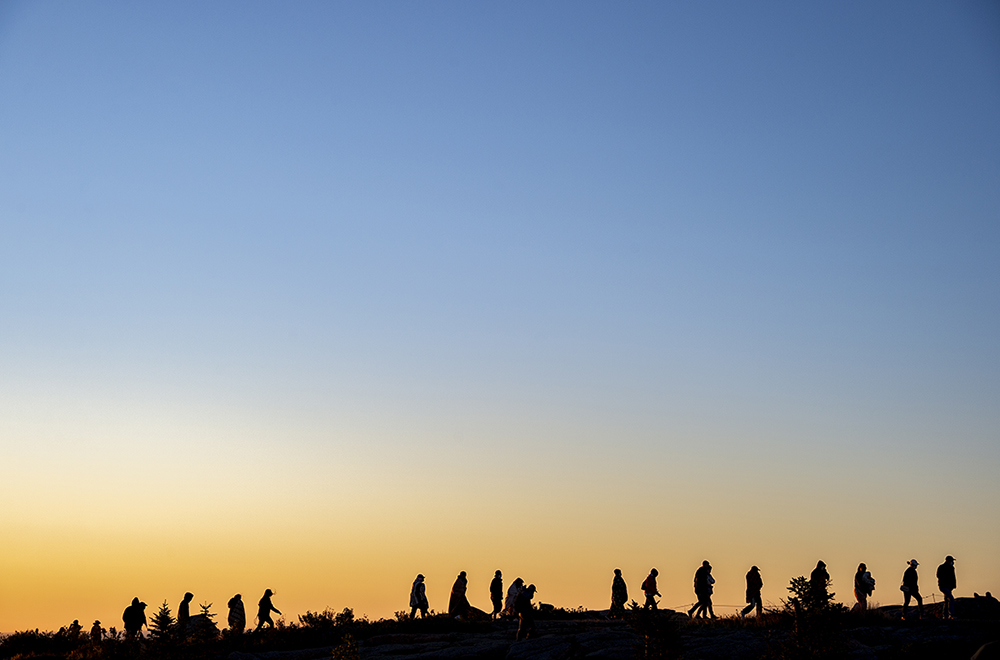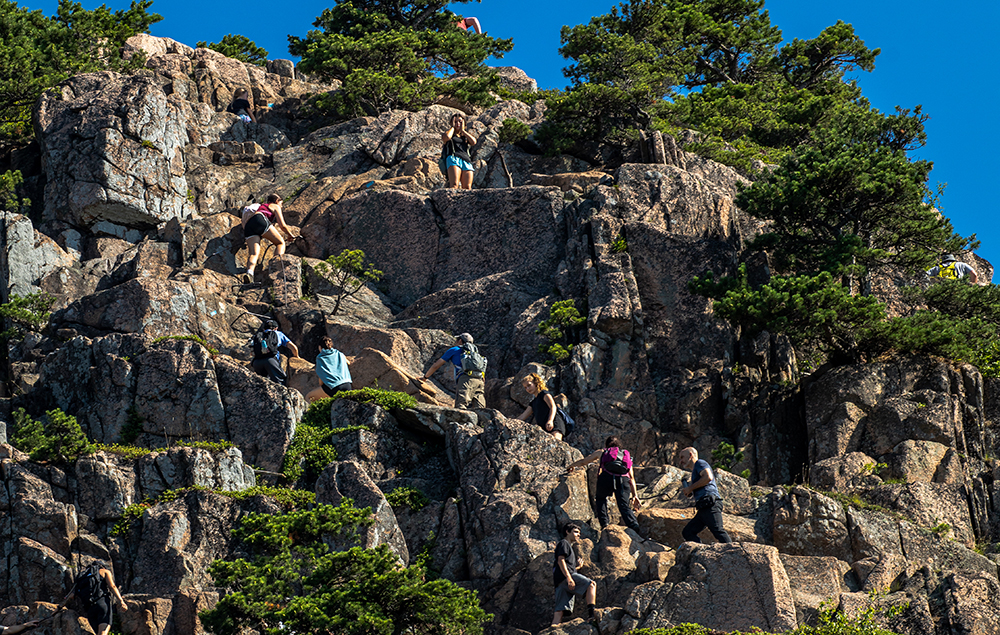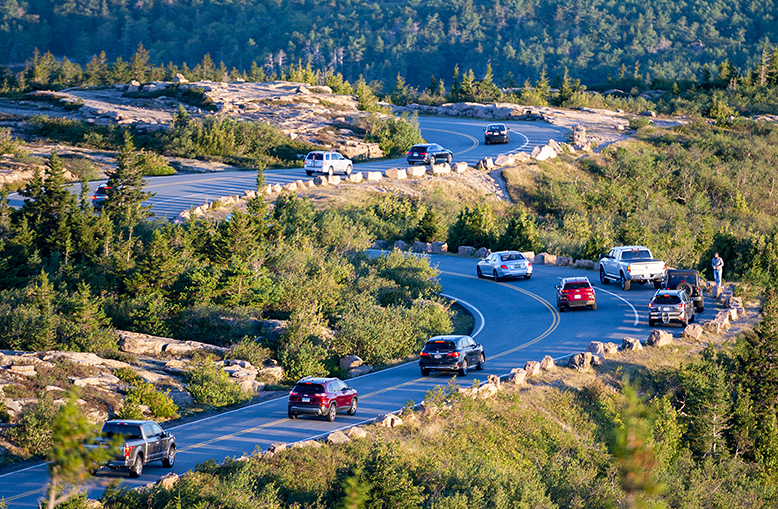What does four million visits mean to Acadia?
“We just had the busiest season in park history… I’m really proud of how our team stepped up.”
– Park Superintendent Kevin Schneider
March 17th, 2022
“We just had the busiest season in park history… I’m really proud of how our team stepped up.”
– Park Superintendent Kevin Schneider
March 17th, 2022

Park visitors walk from the summit of Cadillac mountain after watching the sun rise in Acadia National Park. (Photo by Will Newton/Friends of Acadia)
BY STEPHANIE CLEMENT AND BECCA STANLEY
Whether you visited Acadia once or many times in 2021, chances are you noted an uptick in the number of visitors in the park. Now, that uptick is quantified: Acadia National Park set a record of 4.07 million estimated visits in 2021.
That’s an increase of about 15 percent over the previous visitation record of 3.5 million visits in 2018, and 23 percent over the pre-pandemic five-year average visitation of 3.3 million visits.
“We just had the busiest season in park history,” said Park Superintendent Kevin Schneider. “It’s wonderful to see so many people enjoying Acadia’s natural beauty, but it does make our job of ensuring that visitors have high-quality experiences much more challenging. I’m really proud of how our team stepped up in a record year, during a COVID pandemic, to meet that demand with far fewer resources.”
What does four million visits mean to Acadia? Friends of Acadia set out to characterize some of the impacts from 2021 and think about what lies ahead in 2022 and beyond.

Park visitors Taylor Thompson and Russell Bloom wrap themselves and their dog Chloe in a blanket to stay warm while waiting for the sunrise on top of Cadillac mountain in Acadia National Park. (Photo by Will Newton/Friends of Acadia)
Acadia National Park’s Social Scientist Adam Gibson tracked several key trends behind the visitation numbers in 2021, and they help tell the story. It’s not just the large increases in the number of people visiting Acadia that present challenges, but also changes in the time of year visitors come, how they arrive, and how they want to engage in the park.
Acadia has hit a record number of visits in every month since October of 2020. Visitation in 2021 ramped up faster and earlier (April and May) and extended later (September, October, November) creating extra challenges for staffing.
A greater number of those visits were by car. Ninety- eight percent of visitors entering the park in 2021 were in a personal vehicle, compared to 90 percent during pre- pandemic times. There were about 210,000 more cars in the park in 2021 than 2019. Much of that increase could be attributed to COVID-related limitations with the Island Explorer bus system, which operated on reduced routes and with fewer passengers allowed per bus in 2021.
Additionally, data from the Maine Department of Transportation showed that more visitors to Maine are coming to Acadia, and more of them in cars.
Visitation is not distributed evenly throughout the park. More than 90 percent of visits were to the Mount Desert Island section of the park, which exacerbated the issues of traffic congestion and crowding.
Finally, Acadia is not alone. In 2021, six national parks set visitation records and countless more were challenged with increased crowds and congestion. Great Smoky Mountains, Yellowstone, Grand Teton, Glacier, Acadia, and Arches have all reported record visitation in 2021. Three national parks— Glacier, Rocky Mountain, and Yosemite—have reservation systems in place which limit their visitation.

Visitors sit watching the ocean at Otter Cliffs along Park Loop Road in Acadia National Park. (Photo by Lily LaRegina/Friends of Acadia)
The Cadillac Summit Road vehicle reservation system was designed to help reduce congestion and improve the visitor experience on the Cadillac summit, and by all accounts it was a success in its first year.
Anecdotal observations and visitor comments proclaimed their visitor experience improved compared to their previous years visiting Cadillac Mountain. That’s consistent with what Friends of Acadia Summit Stewards reported from their work on Cadillac with the reservation system in place.
The reservation system operated for 147 days—from May 26-Oct. 19, 2021—and according to Recreation.gov, 85 percent of the total available reservations were sold; 99.5 percent of sunrise reservations. About 42 percent of the reservations were made the same day.
Perhaps the most compelling argument for the reservation system is data Gibson presented that estimated what would have happened if there were no reservation system. It showed that the Cadillac summit would have seen an average of more than 600 cars overparked each day.
“If you made a reservation, the Cadillac summit was the one place you could be assured a parking spot in the park on a busy day,” said Park Superintendent Schneider.
The sharp, unexpected, and prolonged surge in visitation resulted in a 33% increase in the times park staff had to respond to daily congestion situations, visitor rescues, and other visitor assistance services, as compared to previous years.
Among the highly trafficked areas of Acadia National Park, Jordan Pond House, Bass Harbor Head Lighthouse, and the Ocean Drive corridor experienced a high volume of congestion and numerous parking problems.
Our national parks are struggling with a substantial operations budget shortfall, including significant understaffing. Concurrent to high visitation, national park budgets have, in essence, decreased when accounting for inflation over the last 10 years.
This is beginning to capture the attention of lawmakers in Washington, including U.S. Senator Angus King (I-ME), the Chair of the Subcommittee on National Parks. At a December 2, 2021, Senate Energy and Natural Resources Committee hearing on outdoor recreation Senator King said: “We’ve got a real problem with staffing in our national parks. In 2011, there were 22,000 FTEs in the National Park Service and, in 2020, only 18,000. In other words, staffing is declining, while visitation has gone from 278 million to 327 million. Added together that’s about a 30% gap from where we were in 2011.”
“We’ve got to do something about staffing levels, or we can’t serve the public adequately,” Sen. King added. If we’re going to invite people to the outdoors, we’ve got to be able to meet their needs.”

ACADIA NATIONAL PARK, MAINE – JUNE 29, 2021 — A line of hikers climb up the Beehive Trail on Tuesday, June 29, 2021 in Acadia National Park. As the park’s volume of visitors increase and the summer season gets hotter, more and more visitors are trekking the more popular trails as early as possible – here, visitors climb at eight in the morning. (Photo by Sam Mallon/Friends of Acadia)
Visitation to Acadia is a complex issue with many inter- related factors. If the visitation forecast holds true, 2022 will be just as busy as 2021. How can Friends of Acadia help the park manage visitation and create a better visitor experience?
Investments are being made in five areas: infrastructure, transportation, education, monitoring, and advocacy. Acadia National Park has made significant strides in managing visitation through the implementation of the Transportation Plan, and Friends of Acadia has funded the planning, design, and engineering for the infrastructure improvements at Cadillac that were needed for the reservation system. Friends of Acadia stands ready to help the park consider improvements that are needed at future reservation areas, including Jordan Pond, Ocean Drive, and Bass Harbor Head Light.
The fare-free, propane-powered Island Explorer bus system is expected to return to normal service in 2022 if COVID allows. Through its partnership with L.L.Bean, Friends of Acadia helps fund the Island Explorer as an efficient way for visitors to access destinations in the park and local communities, thereby reducing traffic congestion, parking hassles, and vehicle pollution
Friends of Acadia has also been a long-term partner in the Acadia Gateway Center, a transit and visitor information center being planned on Route 3 in Trenton. In the final design phase now, the project will hopefully enter construction in 2023 with a potential opening in 2025.
The Summit Stewards serve as field contacts and help educate visitors when they are here, and Friends of Acadia is considering new ways to connect with visitors before they arrive. In 2021, the Summit Stewards observed increases in prohibited behaviors that can have harmful impacts on the park–such as pets without a leash or dismantled cairns (trail markers). This is likely due to increased visitation, and it reinforces the importance of the program.
Friends of Acadia’s Recreation Technicians assist with monitoring visitor use statistics and providing critical data that will help the park make future decisions about managing visitation.
And finally, Friends of Acadia helps the park by advocating for additional operating dollars from Congress. As the climate changes and the visitor season lengthens, six-month seasonal employment will no longer match the park’s visitor season. As visitation pressures increase, Acadia must be able to hire and retain permanent employees to ensure visitor safety, maintain infrastructure, and protect the park’s natural and cultural resources.
Park visitors and supporters have a key role to play in the future of Acadia. While Friends of Acadia, the park and partners are using new tools to manage record visitation, the individual choices and actions of visitors will go a long way to safeguarding the park.

Cars drive down the Cadillac mountain road after viewing the sun rise in Acadia National Park. (Photo by Will Newton/Friends of Acadia)
The National Park Service estimates the number of visits to the park, not individual visitors. An individual visitor is counted as a visit each day they enter the park.
HERE’S HOW IT WORKS: Vehicle counters are located on both lanes of the Park Loop Road near the Sand Beach entrance station, counting the actualnumber of cars passing through. To estimate visits, the traffic count at that location is multiplied by a “vehicle expansion” multiplier to estimate the number of vehicles going to all the other recreation areas in the park.
The adjusted vehicle count is then multiplied by the “persons-per-vehicle” multiplier.
Bus and van traffic is calculated using a slightly different methodology.
While the visitation numbers are inexact, they are good estimates and do show trends in park visitation that are useful for year-to-year comparisons.
The record visitation in 2021 is based on the same method used since 1990 to estimate visits. Visitation records were higher prior to 1990, but they were based on a different system of estimating visits.
STEPHANIE CLEMENT is Friends of Acadia’s Conservation Director and BECCA STANLEY is Friends of Acadia’s Recreation Technician Lead.
This article was in the Winter/Spring 2022 Acadia magazine.